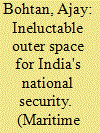| Srl | Item |
| 1 |
ID:
117147


|
|
|
|
|
| Publication |
2012.
|
| Summary/Abstract |
January 26, 2013; Somewhere off the Sir Creek: An important naval operation is called for during the early morning hours to support a team of the Army's elite Special Forces (SF) deployed inland as part of a force committed to breaking up a concentration of terrorists with ties to an international organisation. The weather forecast predicts clear skies. As the operation commences just after sunrise heavy fog descends on the sea coast. The SF team moves in as per the previously decided H-hour expecting fire support from sea. The laser designator to direct the missile from the ship fails to acquire the target. The fire support however, continues without accurate spotting due to reduced visibility. Radio communications between the SF team and the naval ship become unreliable. By the time news of the SF advance and their new positions are relayed to the naval commander, the SF team has taken significant casualties. Some terrorists escape although the operation is declared a success. However, the conduct of such joint operations in the future is now endangered. Subsequent analysis released by the navy's meteorological department suggests that an early morning temperature inversion was the cause of the fog build-up and the strong atmospheric gradient resulted in poor radio communications.
August 15, 2013; Somewhere off the Coast of Andaman and Nicobar Islands: A ship suspected of carrying contraband arms has been tracked and is heading for the harbour of a hostile naval base. A Marine Commando team is to be dispatched by a high-speed boat to intercept, board, and take control of the vessel. The team leader checks with the Met officer and ascertains that the wave heights are averaging 3 feet from the southeast. He estimates the intercept can be made a few miles before the ship enters hostile waters if the boat averages 10 knots. The moment the mission is launched at 2300 hours, a tornado develops and the wave height reaches 6 feet. As the boat picks up speed, the violent shocks of the craft engaging the 6-foot seas directly on the bow become unbearable to the team and the boat crew. The boat had to slow to 5 knots and finally the intercept is missed.
|
|
|
|
|
|
|
|
|
|
|
|
|
|
|
|
| 2 |
ID:
126688


|
|
|
|
|
| Publication |
2013.
|
| Summary/Abstract |
Outer space, or simply space, is the void that exists between celestial bodies. This frontier of outer space is fast emerging as the fourth dimension (after land, sea and air) for military applications. Space will undoubtedly be the military high ground for warfare in the future acting as a "force multiplier" for any military operation. Militarization of space involves use of space technology for exploiting weapons on the ground and in the earth's atmosphere with more accuracy. India has to defend her physical, economic and cultural identity in the prevalent geo-political milieu as it faces varied and complex security challenges. There is a clear and present danger that sooner or later space could be weaponized by various countries. India can no longer be immune to the rapidly changing international security environment, threat to India's national security from nuclear and missile capabilities in its neighbourhood and the vulnerabilities of its space assets. It is therefore imperative that India exploits the capabilities of space, concurrently at appropriate levels, to achieve the desired operational capabilities in a compressed time frame. Since the early 1990s, the Indian armed forces have benefitted from the Indian Space Research Organisation (ISRO) civilian satellites. However, as operational requirements now demand an increase in military capabilities, the armed forces certainly need dedicated military satellites. This space capability has to be optimally exploited by the three services of the Indian defence forces with synergy and harmony, which is possible only under a single appropriate command structure. It is high time that India realizes: "To remain in Race, the Indian armed forces should be in Space".
|
|
|
|
|
|
|
|
|
|
|
|
|
|
|
|